Triage Algorithms for Mass-Casualty Bioterrorism: A Systematic Review
Abstract
1. Background
2. Methods
2.1. Search Strategy
2.2. Inclusion Criteria
- -
- Specific triage algorithms for bioterrorism events caused by various biological agents.
- -
- Triage algorithms that can be used in bioterrorism attacks regardless of the types of biological agents.
- -
- Specific triage algorithms for mental or psychosocial problems caused by bioterrorism events.
2.3. Exclusion Criteria
- -
- Articles without specific triage algorithms.
- -
- Triage algorithms that do not apply only to bioterrorism.
- -
- Articles that are not written in English.
- -
- Articles without full texts.
- -
- Letters to editors or conference papers without full texts.
2.4. Data Extraction
2.5. Quality Assessment
3. Results
3.1. Triage Algorithms for Most Bioterrorism Events
3.2. Triage Algorithm for Anthrax
3.3. Cutaneous Anthrax
3.4. Inhalational Anthrax
3.5. Triage Algorithms for Mental or Psychosocial Problems Caused by Bioterrorism Events
4. Discussion
4.1. Triage Algorithms for Most Bioterrorism Events
4.2. Triage Algorithm for Anthrax
4.3. Triage Algorithms for Mental or Psychosocial Problems Caused by Bioterrorism Events
5. Limitations
6. Conclusions
Supplementary Materials
Author Contributions
Funding
Institutional Review Board Statement
Informed Consent Statement
Data Availability Statement
Conflicts of Interest
References
- Sellers, D.; Ranse, J. The impact of mass casualty incidents on intensive care units. Aust. Crit. Care 2020, 33, 469–474. [Google Scholar] [CrossRef]
- Mistovich, J.J.; Karren, K.J.; Werman, H.A.; Hafen, B.Q. Prehospital Emergency Care; Pearson/Prentice Hall: Hoboken, NJ, USA, 2008. [Google Scholar]
- VandenBerg, S.L.; Davidson, S.B. Preparation for mass casualty incidents. Crit. Care Nurs. Clin. North Am. 2015, 27, 157–166. [Google Scholar] [CrossRef] [PubMed]
- World Health Organization. Disaster Risk Management for Health: Mass Casualty Management; WHO: Geneva, Switzerland, 2011. [Google Scholar]
- Goralnick, E.; Van Trimpont, F.; Carli, P. Preparing for the Next Terrorism Attack: Lessons From Paris, Brussels, and Boston. JAMA Surg. 2017, 152, 419–420. [Google Scholar] [CrossRef]
- Wisnewski, J.J. (Ed.) Torture, Terrorism, and the Use of Violence; Cambridge Scholars Publishing: Newcastle, UK, 2008. [Google Scholar]
- Croddy, E. Chemical and Biological Warfare: A Comprehensive Survey for the Concerned Citizen; Copernicus Books: New York, NY, USA, 2002. [Google Scholar]
- Anderson, P.D.; Bokor, G. Bioterrorism: Pathogens as weapons. J. Pharm. Pract. 2012, 25, 521–529. [Google Scholar] [CrossRef] [PubMed]
- Barras, V.; Greub, G. History of biological warfare and bioterrorism. Clin. Microbiol. Infect. 2014, 20, 497–502. [Google Scholar] [CrossRef]
- Trevisanato, S.I. The ‘Hittite plague’, an epidemic of tularemia and the first record of biological warfare. Med. Hypotheses 2007, 69, 1371–1374. [Google Scholar] [CrossRef]
- Robertson, A.G.; Robertson, L.J. From asps to allegations: Biological warfare in history. Mil. Med. 1995, 160, 369–373. [Google Scholar] [CrossRef] [PubMed]
- Geissler, E.; van Courtland Moon, J.E. Biological and Toxin Weapons: Research, Development and Use from the Middle Ages to 1945; Oxford University Press: Cary, NC, USA, 1999. [Google Scholar]
- Edmonds, J.; Lindquist, H.D.; Sabol, J.; Martinez, K.; Shadomy, S.; Cymet, T.; Emanuel, P. Multigeneration Cross-Contamination of Mail with Bacillus anthracis Spores. PLoS ONE 2016, 11, e0152225. [Google Scholar] [CrossRef]
- Chambers, J.; Yarrarapu, S.N.S.; Mathai, J.K. Anthrax Infection. In StatPearls; StatPearls Publishing: Treasure Island, FL, USA, 2022. [Google Scholar]
- Christian, M.D. Triage. Crit. Care Clin. 2019, 35, 575–589. [Google Scholar] [CrossRef]
- Bazyar, J.; Farrokhi, M.; Salari, A.; Khankeh, H.R. The Principles of Triage in Emergencies and Disasters: A Systematic Review. Prehosp. Disaster Med. 2020, 35, 305–313. [Google Scholar] [CrossRef] [PubMed]
- Bazyar, J.; Farrokhi, M.; Khankeh, H. Triage Systems in Mass Casualty Incidents and Disasters: A Review Study with A Worldwide Approach. Open Access Maced. J. Med. Sci. 2019, 7, 482–494. [Google Scholar] [CrossRef] [PubMed]
- Cone, D.C.; Koenig, K.L. Mass casualty triage in the chemical, biological, radiological, or nuclear environment. Eur. J. Emerg. Med. 2005, 12, 287–302. [Google Scholar] [CrossRef]
- Kahn, C. History of Smallpox and Its Prevention. Am. J. Dis. Child 1963, 106, 597–609. [Google Scholar] [CrossRef] [PubMed]
- Page, M.J.; McKenzie, J.E.; Bossuyt, P.M.; Boutron, I.; Hoffmann, T.C.; Mulrow, C.D. The PRISMA 2020 statement: An updated guideline for reporting systematic reviews. BMJ 2021, 372, n71. [Google Scholar] [CrossRef] [PubMed]
- Torre, G.L. Rating for narrative reviews: Concept and development of the International Narrative Systematic Assessment tool. Senses Sci. 2015, 2, 31–35. [Google Scholar] [CrossRef]
- Burkle, F.M. Mass casualty management of a large-scale bioterrorist event: An epidemiological approach that shapes triage decisions. Emerg. Med. Clin. North Am. 2002, 20, 409. [Google Scholar] [CrossRef]
- Sox, H.C. A Triage Algorithm for Inhalational Anthrax. Ann. Intern. Med. 2003, 139, 379–381. [Google Scholar] [CrossRef] [PubMed]
- Bracha, H.S.; Burkle, F.M. Utility of fear severity and individual resilience scoring as a surge capacity, triage management tool during large-scale, bio-event disasters. Prehospital Disaster Med. 2006, 21, 290–296. [Google Scholar] [CrossRef] [PubMed]
- Engel, C.C.; Locke, S.; Reissman, D.B.; DeMartino, R.; Kutz, I.; McDonald, M.; Barsky, A.J. Terrorism, trauma, and mass casualty triage: How might we solve the latest mind-body problem? Biosecurity Bioterrorism 2007, 5, 155–163. [Google Scholar] [CrossRef]
- Melnick, A.L. Biological, Chemical, and Radiological Terrorism: Emergency Preparedness and Response for the Primary Care Physician; Springer: New York, NY, USA, 2007; pp. 1–248. [Google Scholar] [CrossRef]
- Bond, W.F.; Subbarao, I.; Kimmel, S.R.; Kuklinski, J.; Johnson, C.; Eberhardt, M.; Vozenilek, J. Testing the use of symptom-based terrorism triage algorithms with hospital-based providers. Prehospital Disaster Med. 2008, 23, 234–241. [Google Scholar] [CrossRef]
- Anan, H.; Otomo, Y.; Kondo, H.; Homma, M.; Koido, Y.; Morino, K.; Oshiro, K.; Harikae, K.; Akasaka, O. Development of Mass-casualty Life Support-CBRNE (MCLS-CBRNE) in Japan. Prehospital Disaster Med. 2016, 31, 547–550. [Google Scholar] [CrossRef]
- Hupert, N.; Person, M.; Hanfling, D.; Traxler, R.M.; Bower, W.A.; Hendricks, K. Development and Performance of a Checklist for Initial Triage After an Anthrax Mass Exposure Event. Ann. Intern. Med. 2019, 170, 521. [Google Scholar] [CrossRef]
- Kahn, C.A.; Schultz, C.H.; Miller, K.T.; Anderson, C.L. Does START triage work? An outcomes assessment after a disaster. Ann. Emerg. Med. 2009, 54, 424–430. [Google Scholar] [CrossRef]
- Reith, F.C.; Van den Brande, R.; Synnot, A.; Gruen, R.; Maas, A.I. The reliability of the Glasgow Coma Scale: A systematic review. Intensive Care Med. 2016, 42, 3–15. [Google Scholar] [CrossRef]
- Johnston, G.M.; Wills, B.K. Chemical Decontamination. In StatPearls; StatPearls Publishing LLC: Treasure Island, FL, USA, 2022. [Google Scholar]
- Subbarao, I.; Johnson, C.; Bond, W.F.; Schwid, H.A.; Wasser, T.E.; Deye, G.A.; Burkhart, K.K. Symptom-based, algorithmic approach for handling the initial encounter with victims of a potential terrorist attack. Prehosp Disaster Med. 2005, 20, 301–308. [Google Scholar] [CrossRef]
- Cox, R.D. Decontamination and management of hazardous materials exposure victims in the emergency department. Ann. Emerg. Med. 1994, 23, 761–770. [Google Scholar] [CrossRef]
- Houston, M.; Hendrickson, R.G. Decontamination. Crit Care Clin 2005, 21, 653–672. [Google Scholar] [CrossRef] [PubMed]
- Macintyre, A.G.; Christopher, G.W.; Eitzen, E., Jr.; Gum, R.; Weir, S.; DeAtley, C.; Tonat, K.; Barbera, J.A. Weapons of mass destruction events with contaminated casualties: Effective planning for health care facilities. JAMA 2000, 283, 242–249. [Google Scholar] [CrossRef] [PubMed]
- Kennedy, K.; Aghababian, R.; Gans, L.; Lewis, C. Triage: Techniques and Applications in Decisionmaking. Ann. Emerg. Med. 1996, 28, 136–144. [Google Scholar] [CrossRef] [PubMed]
- U.S. Department of Health & Human Services. Guide to Understanding Anthrax; National Center for Emerging and Zoonotic Infectious Diseases: Atlanta, GA, USA, 2016. [Google Scholar]
- Wenner, K.A.; Kenner, J.R. Anthrax. Dermatol. Clin. 2004, 22, 247–256. [Google Scholar] [CrossRef]
- Doucet, J.J.; Boedeker, B.; Jagminas, L. Weapons of mass destruction: Chemical, biological, and radiological warfare agents. In Trauma: Emergency Resuscitation, Perioperative Anesthesia, Surgical Management; CRC Press, LLC: Boca Raton, FL, USA, 2007; Volume 1, pp. 765–793. [Google Scholar]
- Dixon, T.C.; Meselson, M.; Guillemin, J.; Hanna, P.C. Anthrax. N. Engl. J. Med. 1999, 341, 815–826. [Google Scholar] [CrossRef]
- Carucci, J.A.; McGovern, T.W.; Norton, S.A.; Daniel, C.R.; Elewski, B.E.; Fallon-Friedlander, S.; Lushniak, B.D.; Taylor, J.S.; Warschaw, K.; Wheeland, R.G. Cutaneous anthrax management algorithm. J. Am. Acad. Dermatol. 2002, 47, 766–769. [Google Scholar] [CrossRef]
- Christian, M.D. Biowarfare and bioterrorism. Crit. Care Clin. 2013, 29, 717–756. [Google Scholar] [CrossRef]
- Benedek, D.M.; Holloway, H.C.; Becker, S.M. Emergency mental health management in bioterrorism events. Emerg. Med. Clin. North Am. 2002, 20, 393. [Google Scholar] [CrossRef]
- Nelson, C.A.; Meaney-Delman, D.; Fleck-Derderian, S.; Cooley, K.M.; Yu, P.A.; Mead, P.S. Antimicrobial Treatment and Prophylaxis of Plague: Recommendations for Naturally Acquired Infections and Bioterrorism Response. MMWR Recomm. Rep. 2021, 70, 1–27. [Google Scholar] [CrossRef]
- Byers, M.; Russell, M.; Lockey, D.J. Clinical care in the “Hot Zone”. Emerg. Med. J. 2008, 25, 108–112. [Google Scholar] [CrossRef] [PubMed]
- Adalja, A.A.; Toner, E.; Inglesby, T.V. Clinical management of potential bioterrorism-related conditions. N. Engl. J. Med. 2015, 372, 954–962. [Google Scholar] [CrossRef] [PubMed]
- Meaney-Delman, D.; Zotti, M.E.; Rasmussen, S.A.; Strasser, S.; Shadomy, S.; Turcios-Ruiz, R.M.; Wendel, G.D., Jr.; Treadwell, T.A.; Jamieson, D.J. Anthrax cases in pregnant and postpartum women: A systematic review. Obstet. Gynecol. 2012, 120, 1439–1449. [Google Scholar] [CrossRef] [PubMed]
- Beaton, R.; Murphy, S. Psychosocial responses to biological and chemical terrorist threats and events. Implications for the workplace. AAOHN J. 2002, 50, 182–189. [Google Scholar] [CrossRef] [PubMed]

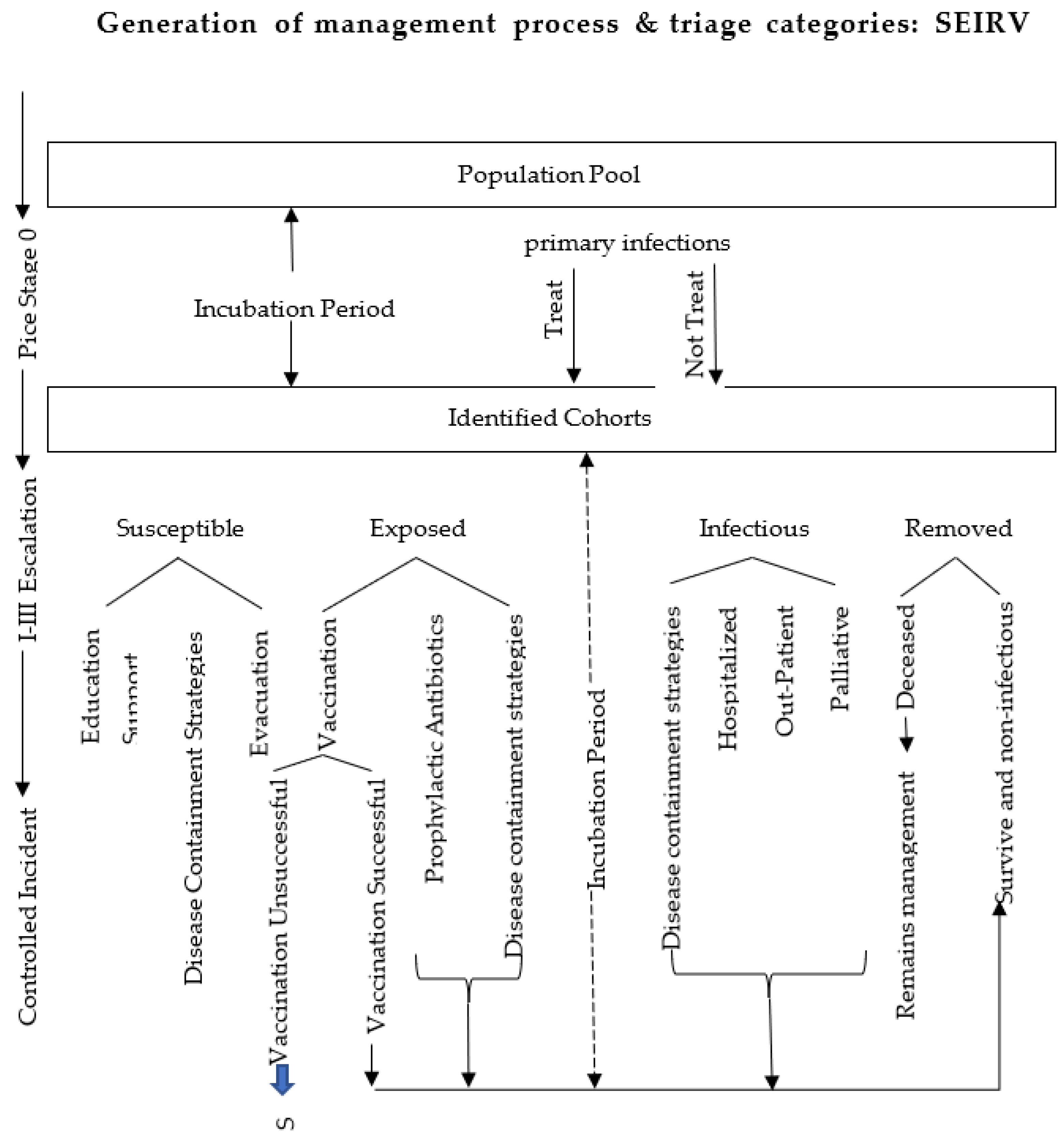
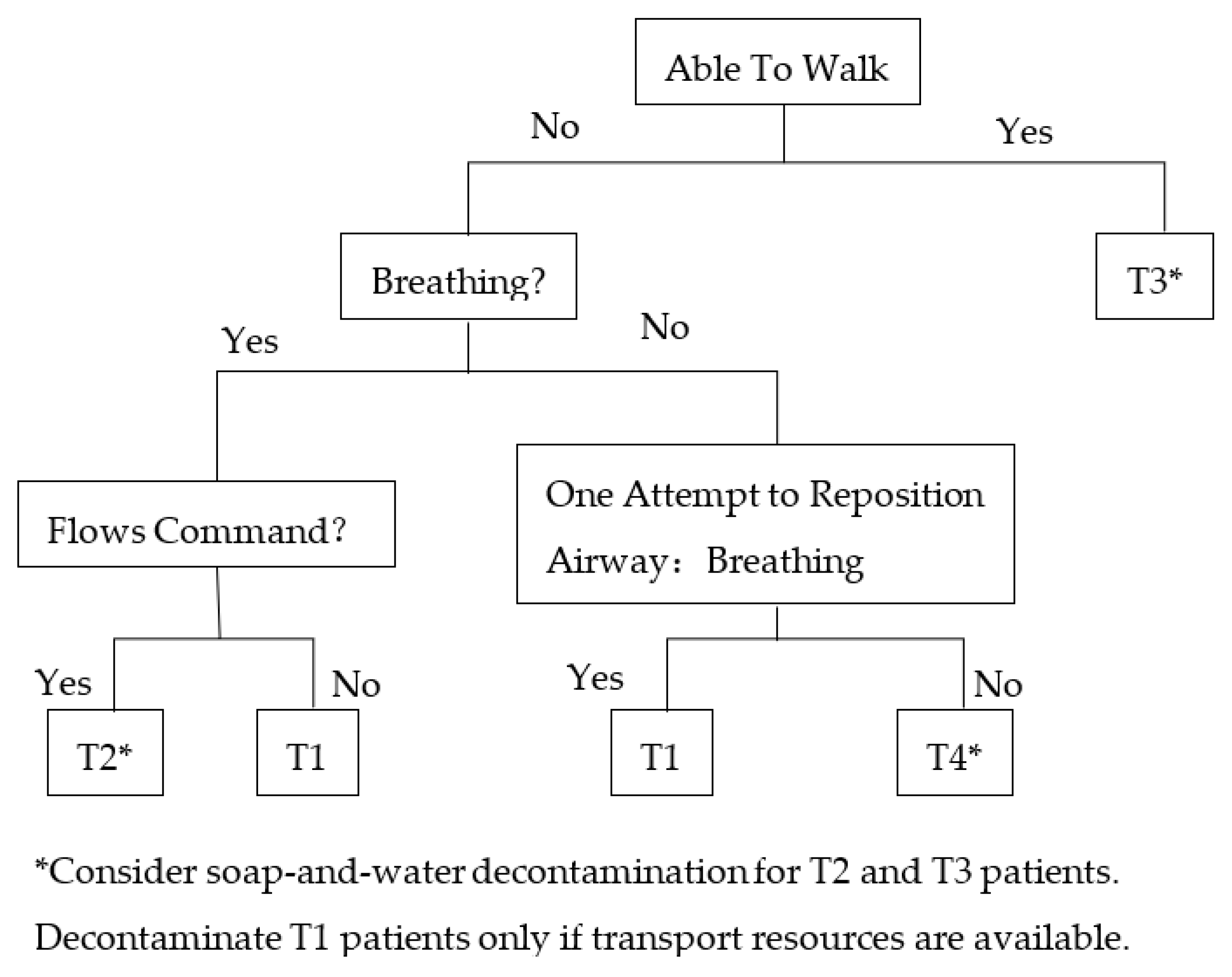

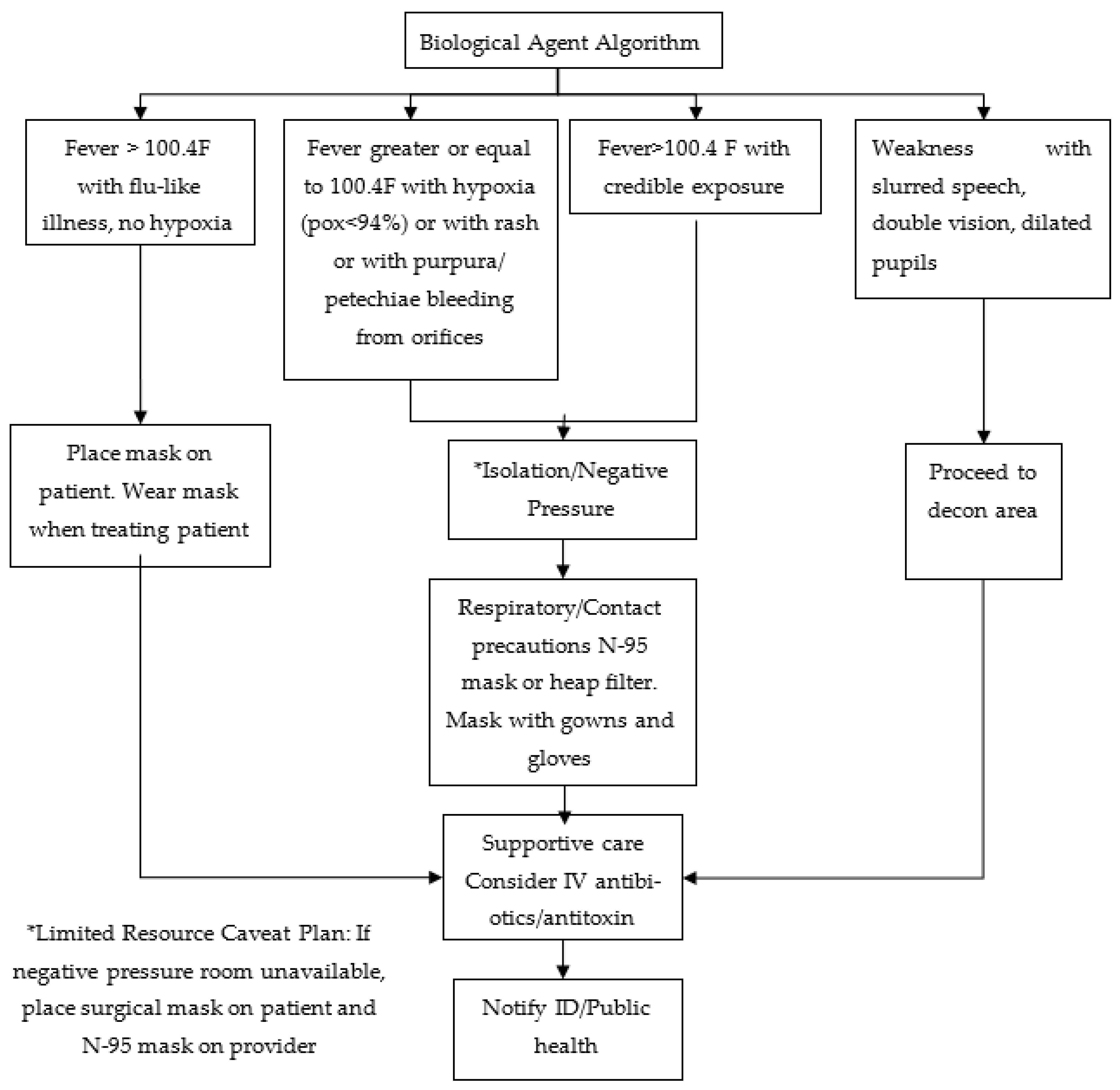
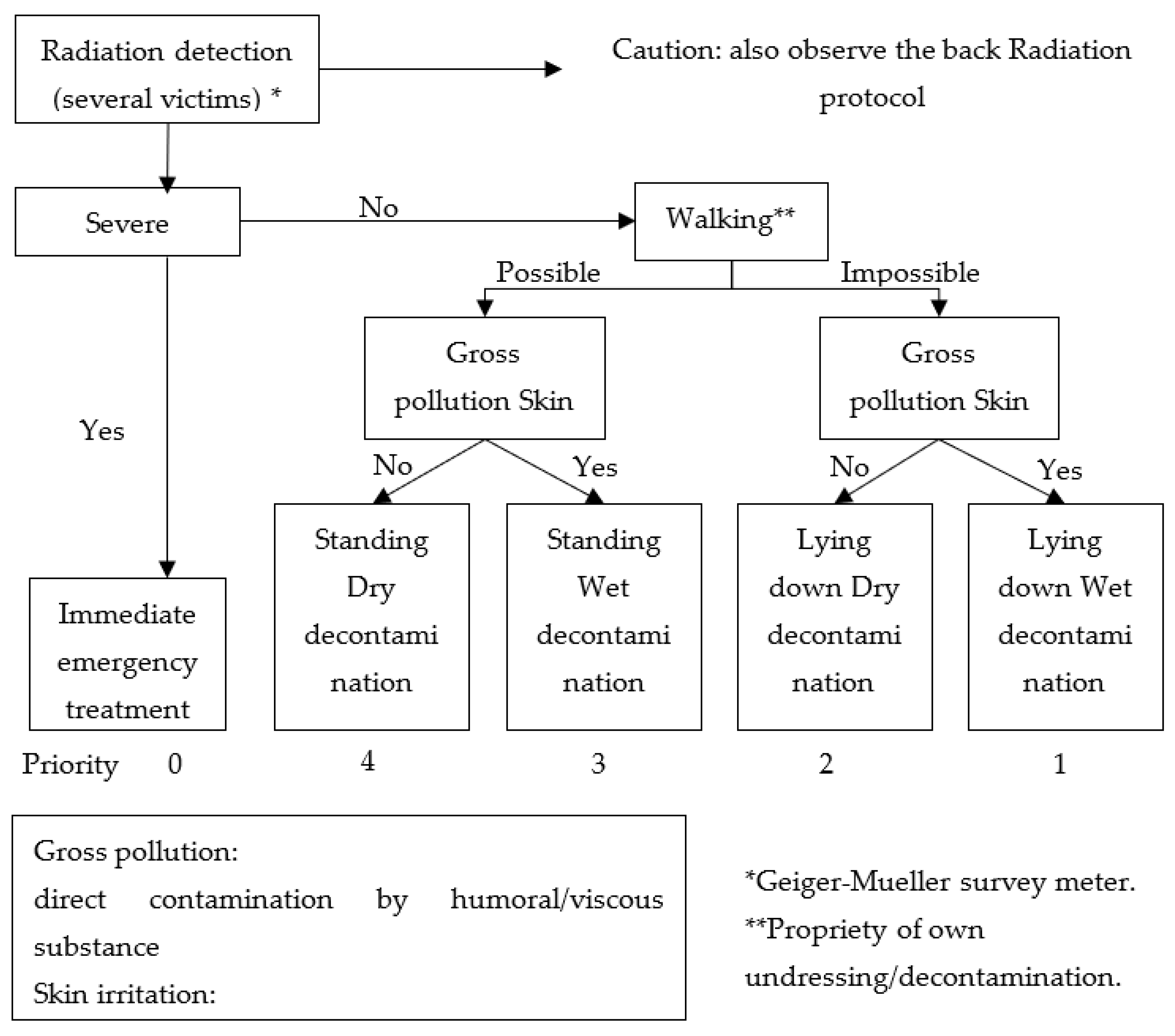
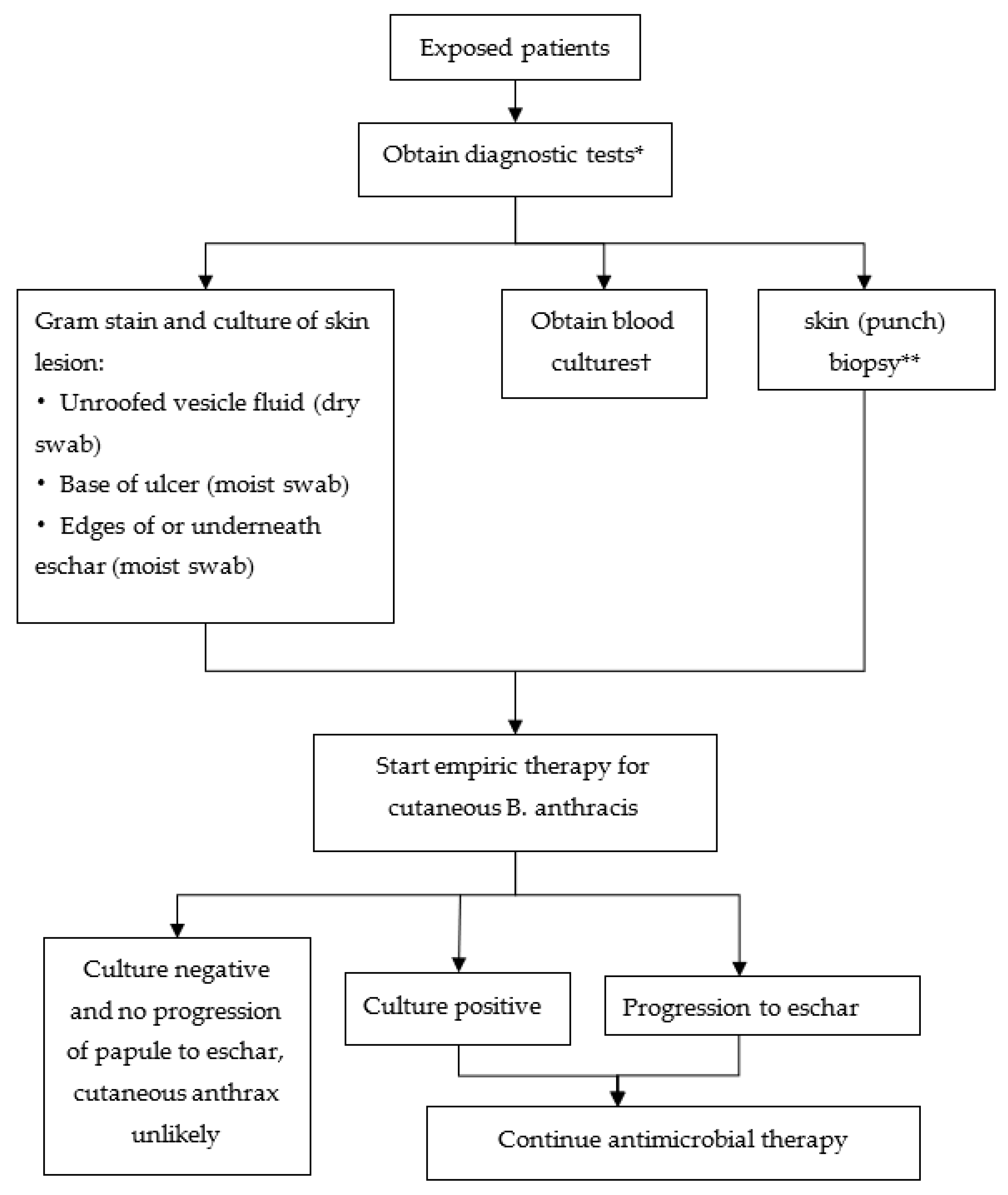
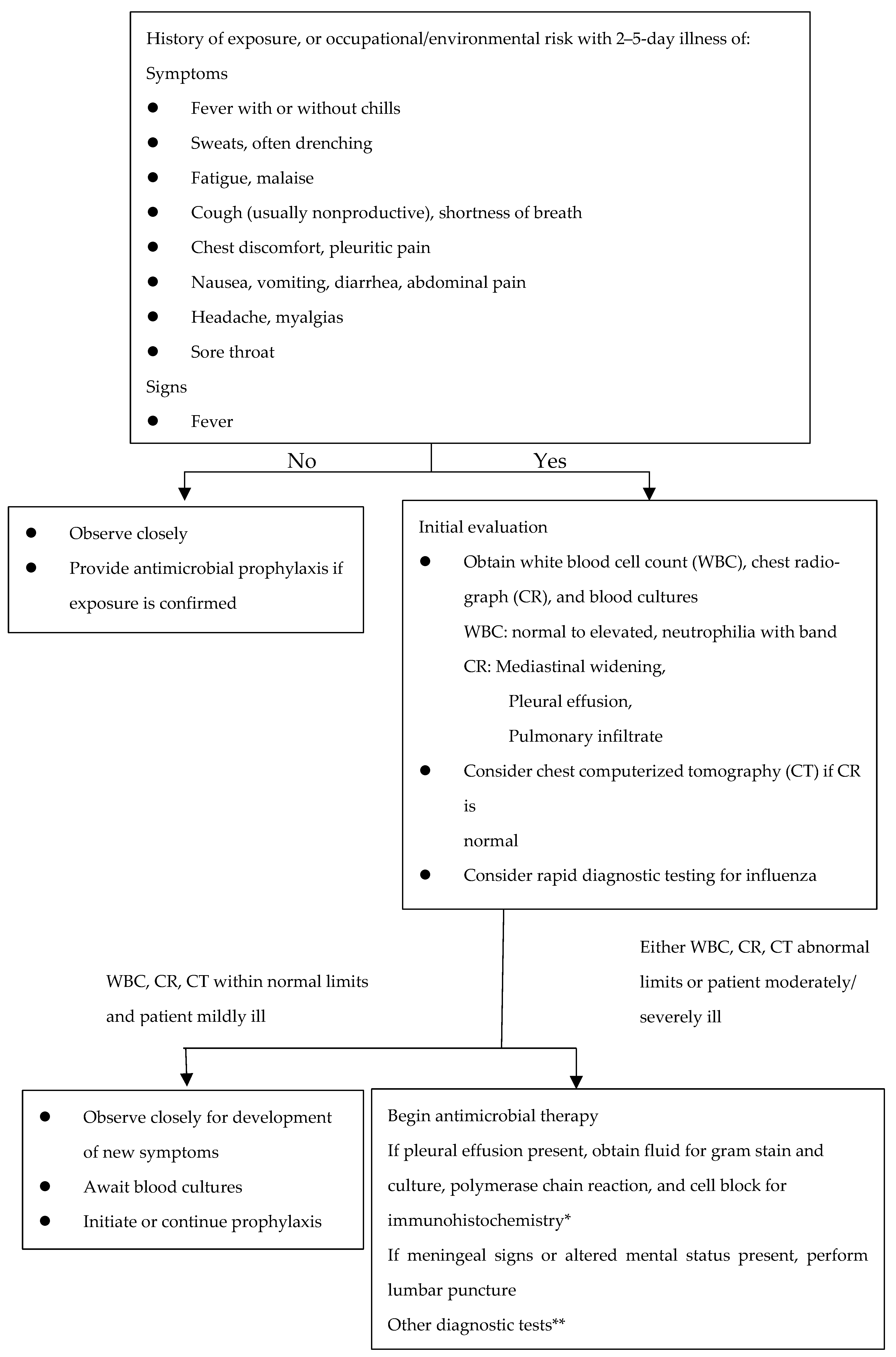
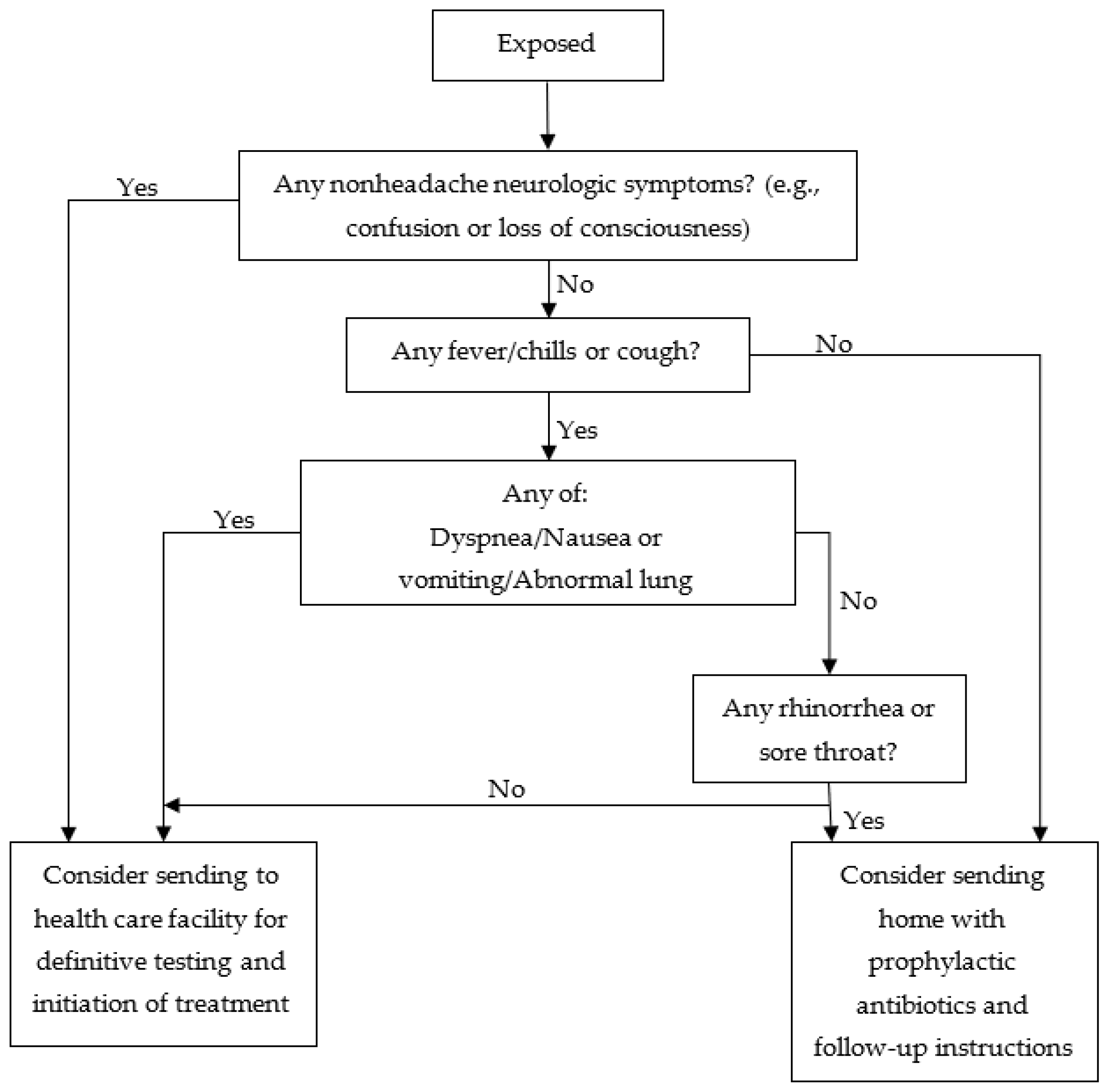
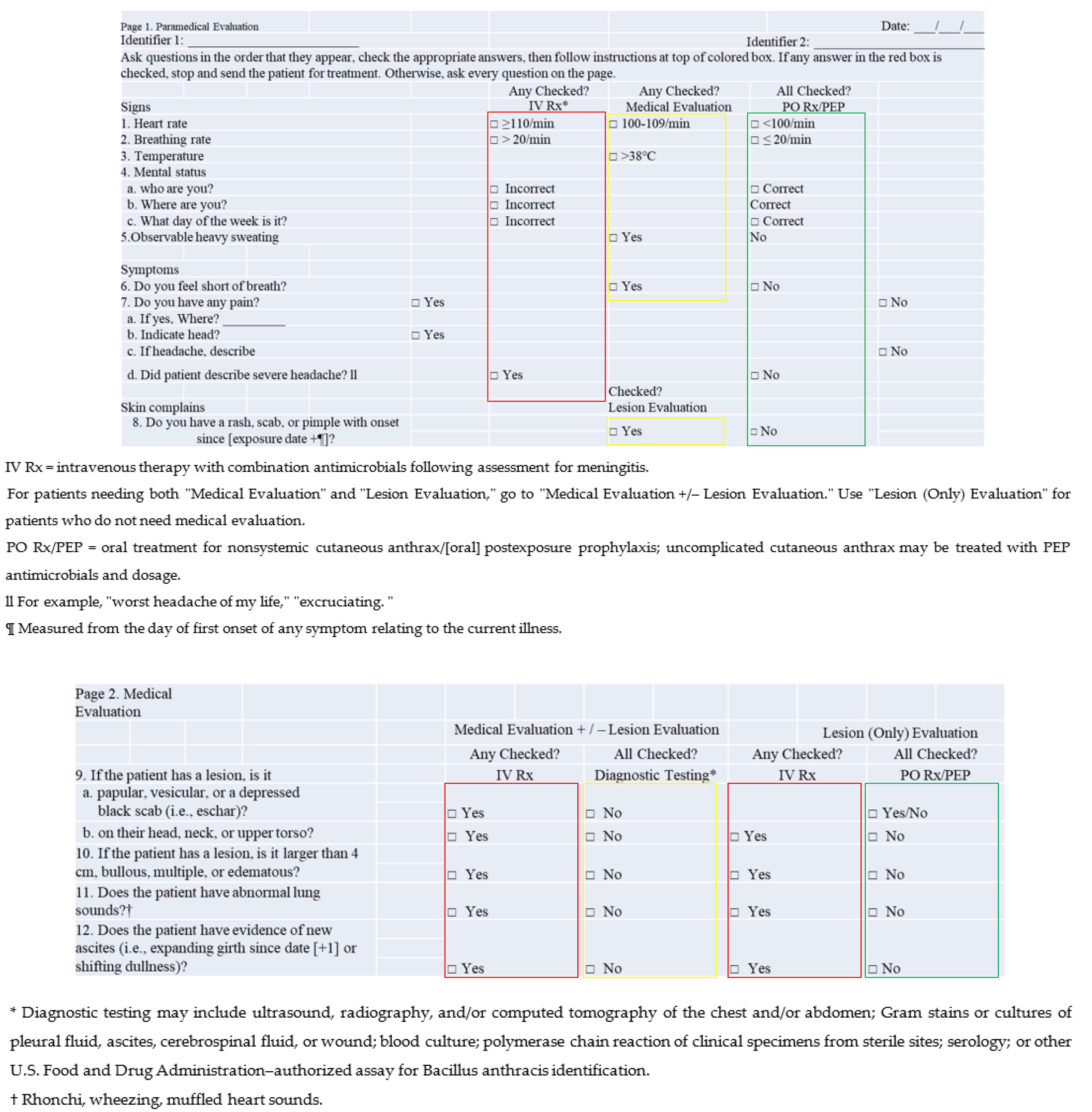

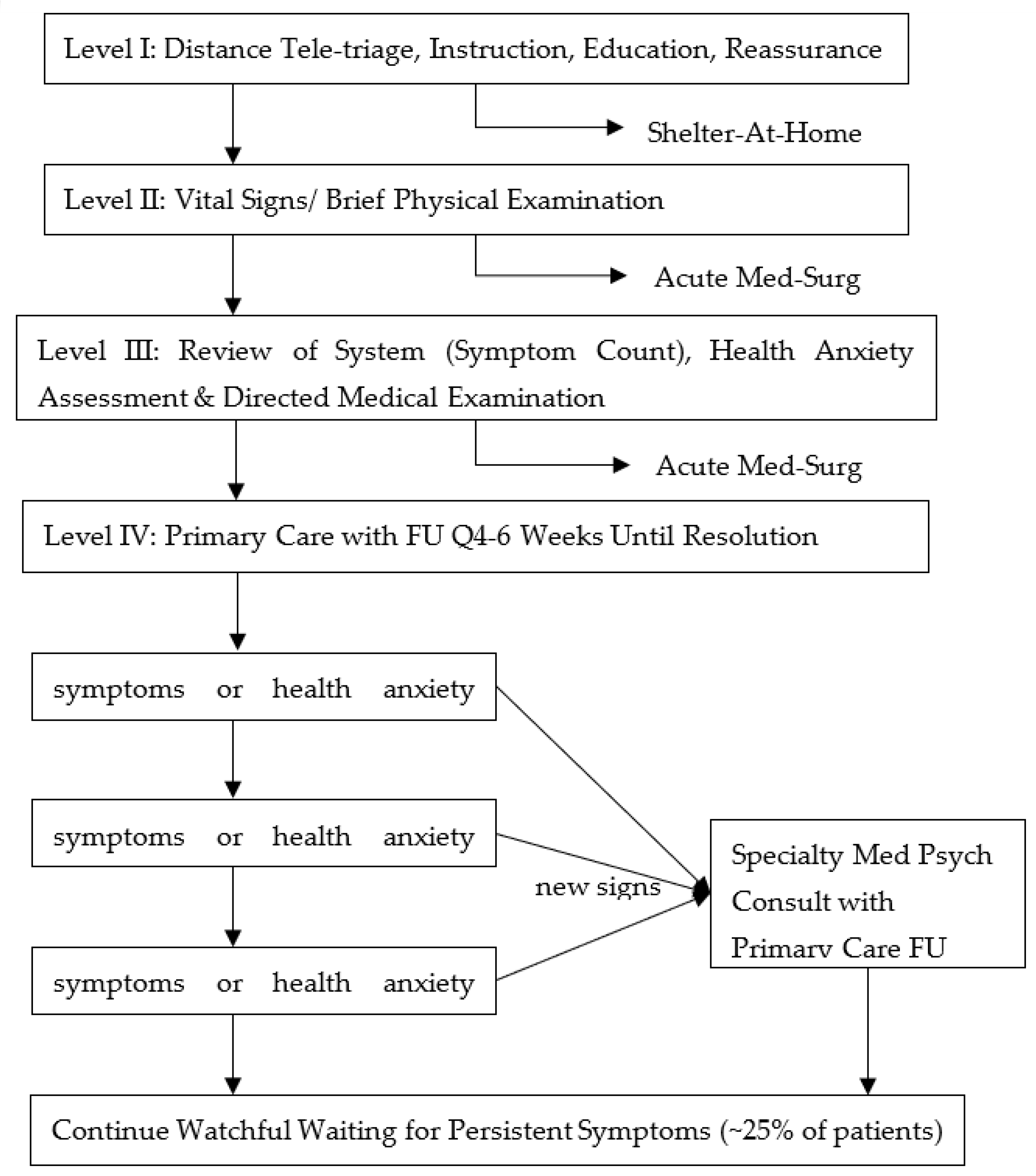
| Search Terms | |||
|---|---|---|---|
| Medline | Web of Science | Scopus | |
| 1. Set of entry criteria | TS = (triage) OR TS = (triages) | ||
| 2. Set of entry criteria | TS = (“Bioterrorism”) OR TS = (Terrorism, Biological) OR TS = (Biological Terrorism) | ||
| 3. Final search | (((“Bioterrorism”[Mesh]) OR (Terrorism, Biological)) OR (Biological Terrorism)) AND ((“Triage”[Mesh]) OR (Triages)) | 1 AND 2 | ((TITLE-ABS-KEY(triage)) OR (TITLE-ABS-KEY(triages))) AND ((TITLE-ABS-KEY(Bioterrorism)) OR (TITLE-ABS-KEY(Terrorism, Biological)) OR (TITLE-ABS-KEY(Biological Terrorism))) |
| No. | Author Name | Year | Title | Total Score | Quality Assessment | Article Type | Triage Algorithm | Applicable Scenario |
|---|---|---|---|---|---|---|---|---|
| 1 | Burkle, F.M. [22] | 2002 | Mass casualty management of a large-scale…… | 4 | L | Review | SEIRV Model | After a bioterrorism attack to disitiguish which patients requiring treatment. |
| 2 | Sox, H.C. [23] | 2003 | A Triage Algorithm for Inhalational Anthrax…… | 4 | L | Editorial Material | Three-tier screening protocol to identify potential early inhalational anthrax cases in the setting of a large-scale anthrax attack | After a anthrax attack. Triage for people who have symptoms of inhalational anthrax. |
| 3 | Cone, D.C. [18] | 2005 | Mass casualty triage in the chemical, biological…… | 5 | H | Review | Triage Algorithm Based on START and the GCS | In the event of a covert release of a biological weapon, overt release or when the source of a biological agent is ascertained |
| 4 | Bracha, H.S. [24] | 2006 | Utility of fear severity and individual resilience…… | 5 | H | Original Research | BIOEVENT FEAR & RESILIENCE (FR)CHECKLIST | After a bioterrorism to identify individuals with excessive levels of fear. |
| 5 | Burkle, F.M. [24] | 2006 | Population-based triage management in response to…… | 4 | L | Article | SEIRV Model | After a biological terrorism to disitiguish which patients requiring treatment. |
| 6 | Engel, C.C. [25] | 2007 | Terrorism, trauma, and mass casualty triage: How…… | 4 | L | Review | Triage algorithm for patients with possible idiopathic physical symptoms and acute health anxiety after a terrorist attack | Healthcare systems’ response to surging demands for triage and management in the event of mass idiopathic illness and overwhelming health anxiety. |
| 7 | Melnick, A.L. [26] | 2007 | Biological, chemical, and radiological terrorism: …… | 5 | H | Book | Triage algorithms for inhalational anthrax and cutaneous anthrax | Clinical evaluation of persons with possible cutaneous anthrax and for patients with possible inhalational anthrax |
| 8 | Bond, W.F. [27] | 2008 | Testing the use of symptom-based terrorism triage…… | 6 | H | Original Research | Attack algorithm and biologic agent algorithm | After a terrorism attack |
| 9 | Anan, H. [28] | 2016 | Development of Mass-casualty Life Support…… | 4 | L | Special Report | Pre-decontamination Triage | Responding to alltypes of CBRNE disasters |
| 10 | Hupert, N. [29] | 2019 | Development and Performance of a Checklist…… | 7 | H | Original Research | Checklist for Initial Triage After an Anthrax Mass Exposure Event | After a anthrax attack to identify anthrax case patients needing intravenous antibiotics. |
| Triage Algorithms | A Triage Algorithm for Inhalational Anthrax | Checklist | Triage Algorithm from Centers for Disease Control and Prevention, Public Domain, of Morbidity and Mortality Weekly Report |
|---|---|---|---|
| Symptoms | non-headache neurologic symptoms | heart rate | fever with or without chills |
| fever, chills or cough | respiratory rate | sweats, often drenching | |
| dyspnea, nausea or vomiting, abnormal lung examination | temperature | fatigue, malaise | |
| mental status | cough shortness of breath | ||
| diaphoresis | chest discomfort, pleuritic pain | ||
| dyspnea | headache, myalgias | ||
| severe headache | sore throat | ||
| characteristic skin lesions | fever | ||
| abnormal lung sounds |
Disclaimer/Publisher’s Note: The statements, opinions and data contained in all publications are solely those of the individual author(s) and contributor(s) and not of MDPI and/or the editor(s). MDPI and/or the editor(s) disclaim responsibility for any injury to people or property resulting from any ideas, methods, instructions or products referred to in the content. |
© 2023 by the authors. Licensee MDPI, Basel, Switzerland. This article is an open access article distributed under the terms and conditions of the Creative Commons Attribution (CC BY) license (https://creativecommons.org/licenses/by/4.0/).
Share and Cite
Zhao, F.; Zhao, C.; Bai, S.; Yao, L.; Zhang, Y. Triage Algorithms for Mass-Casualty Bioterrorism: A Systematic Review. Int. J. Environ. Res. Public Health 2023, 20, 5070. https://doi.org/10.3390/ijerph20065070
Zhao F, Zhao C, Bai S, Yao L, Zhang Y. Triage Algorithms for Mass-Casualty Bioterrorism: A Systematic Review. International Journal of Environmental Research and Public Health. 2023; 20(6):5070. https://doi.org/10.3390/ijerph20065070
Chicago/Turabian StyleZhao, Feida, Chao Zhao, Song Bai, Lulu Yao, and Yongzhong Zhang. 2023. "Triage Algorithms for Mass-Casualty Bioterrorism: A Systematic Review" International Journal of Environmental Research and Public Health 20, no. 6: 5070. https://doi.org/10.3390/ijerph20065070
APA StyleZhao, F., Zhao, C., Bai, S., Yao, L., & Zhang, Y. (2023). Triage Algorithms for Mass-Casualty Bioterrorism: A Systematic Review. International Journal of Environmental Research and Public Health, 20(6), 5070. https://doi.org/10.3390/ijerph20065070





